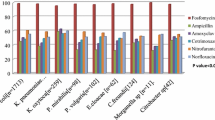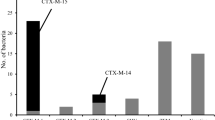Abstract
Fluoroquinolones have been recommended as the drugs of choice for the empirical treatment of uncomplicated and complicated urinary tract infections (UTIs) caused by trimethoprim–sulfamethoxazole-resistant uropathogens. However, because of the increased use of both oral and parenteral fluoroquinolones for other kinds of infections, increasing rates of resistance to fluoroquinolones among the most common uropathogens have challenged this recommendation, particularly in the Asia-Pacific region. The current interpretative criteria for the in vitro susceptibility of uropathogens to some fluoroquinolones, such as levofloxacin and ciprofloxacin, are set according to their therapeutic efficacy for bloodstream infections, and are not specific to UTIs. Fluoroquinolones exhibit concentration-dependent antibacterial activity, high renal excretion, and relatively early and prolonged urinary bactericidal titers. Whether or not current interpretative criteria for the in vitro susceptibility of uropathogens to fluoroquinolones predict clinical failure in treating UTIs is still controversial. The Clinical and Laboratory Standards Institute (CLSI) has established UTI-specific breakpoints for resistance to a few fluoroquinolones. However, the application of high-dose fluoroquinolone therapy for the treatment of mild to moderate UTIs caused by isolates with higher minimum inhibitory concentrations (MICs) of several fluoroquinolones needs to be re-validated based on more relevant clinical studies, prudent pharmacokinetic/pharmacodynamic (PK/PD) considerations, and thorough study of the mutant prevention concentration of fluoroquinolones in the treatment of UTI.


Similar content being viewed by others
References
Schappert SM, Burt CW (2006) Ambulatory care visits to physician offices, hospital outpatient departments, and emergency departments: United States, 2001–02. Vital Health Stat 159:1–66
Foxman B (2002) Epidemiology of urinary tract infections: incidence, morbidity, and economic costs. Am J Med 113(Suppl 1A):5S–13S
Chant C, Smith OM, Marshall JC, Friedrich JO (2011) Relationship of catheter-associated urinary tract infection to mortality and length of stay in critically ill patients: a systematic review and meta-analysis of observational studies. Crit Care Med 39:1167–1173
van der Kooi TI, de Boer AS, Manniën J, Wille JC, Beaumont MT, Mooi BW et al (2007) Incidence and risk factors of device-associated infections and associated mortality at the intensive care in the Dutch surveillance system. Intensive Care Med 33:271–278
Schito GC, Naber KG, Botto H, Palou J, Mazzei T, Gualco L et al (2009) The ARESC study: an international survey on the antimicrobial resistance of pathogens involved in uncomplicated urinary tract infections. Int J Antimicrob Agents 34:407–413
Badal R BS, Hawser S, Hoban D, Hackel M, Hsueh PR (2010) Antimicrobial susceptibility of urinary tract Infection pathogens in Asia-SMART 2009. In: Proceedings of the 12th Western Pacific Congress on Chemotherapy and Infectious Diseases, Singapore, December 2010, abstract no. P026
Gupta K, Hooton TM, Naber KG, Wullt B, Colgan R, Miller LG et al (2011) International clinical practice guidelines for the treatment of acute uncomplicated cystitis and pyelonephritis in women: a 2010 update by the Infectious Diseases Society of America and the European Society for Microbiology and Infectious Diseases. Clin Infect Dis 52:e103–e120
Hooton TM, Bradley SF, Cardenas DD, Colgan R, Geerlings SE, Rice JC et al (2010) Diagnosis, prevention, and treatment of catheter-associated urinary tract infection in adults: 2009 International Clinical Practice Guidelines from the Infectious Diseases Society of America. Clin Infect Dis 50:625–663
Tenke P, Kovacs B, Bjerklund Johansen TE, Matsumoto T, Tambyah PA, Naber KG (2008) European and Asian guidelines on management and prevention of catheter-associated urinary tract infections. Int J Antimicrob Agents 31(Suppl 1):S68–S78
Infectious Diseases Society of the Republic of China, Medical Foundation in Memory of Dr. Deh-Lin Cheng, Foundation of Professor Wei-Chuan Hsieh for Infectious Diseases Research and Education, Lee CY's Research Foundation for Pediatric Infectious Diseases and Vaccine (2000) Guidelines for antimicrobial therapy of urinary tract infections in Taiwan. J Microbiol Immunol Infect 33:271–272
Talan DA, Krishnadasan A, Abrahamian FM, Stamm WE, Moran GJ, EMERGEncy ID NET Study Group (2008) Prevalence and risk factor analysis of trimethoprim–sulfamethoxazole- and fluoroquinolone-resistant Escherichia coli infection among emergency department patients with pyelonephritis. Clin Infect Dis 47:1150–1158
Lau SM, Peng MY, Chang FY (2004) Resistance rates to commonly used antimicrobials among pathogens of both bacteremic and non-bacteremic community-acquired urinary tract infection. J Microbiol Immunol Infect 37:185–191
Clinical and Laboratory Standards Institute (CLSI) (2010) Performance standards for antimicrobial susceptibility testing; 21st informational supplement. CLSI document M100-S21. CLSI, Wayne, PA, USA
Hsueh PR, Hoban DJ, Carmeli Y, Chen SY, Desikan S, Alejandria M et al (2011) Consensus review of the epidemiology and appropriate antimicrobial therapy of complicated urinary tract infections in Asia-Pacific region. J Infect 63:114–123
Karlowsky JA, Hoban DJ, Decorby MR, Laing NM, Zhanel GG (2006) Fluoroquinolone-resistant urinary isolates of Escherichia coli from outpatients are frequently multidrug resistant: results from the North American Urinary Tract Infection Collaborative Alliance-Quinolone Resistance study. Antimicrob Agents Chemother 50:2251–2254
Sahuquillo-Arce JM, Selva M, Perpiñán H, Gobernado M, Armero C, López-Quílez A et al (2011) Antimicrobial resistance in more than 100,000 Escherichia coli isolates according to culture site and patient age, gender, and location. Antimicrob Agents Chemother 55:1222–1228
Zhanel GG, Hisanaga TL, Laing NM, DeCorby MR, Nichol KA, Weshnoweski B et al (2006) Antibiotic resistance in Escherichia coli outpatient urinary isolates: final results from the North American Urinary Tract Infection Collaborative Alliance (NAUTICA). Int J Antimicrob Agents 27:468–475
Viray M, Linkin D, Maslow JN, Stieritz DD, Carson LS, Bilker WB et al (2005) Longitudinal trends in antimicrobial susceptibilities across long-term-care facilities: emergence of fluoroquinolone resistance. Infect Control Hosp Epidemiol 26:56–62
Johnson L, Sabel A, Burman WJ, Everhart RM, Rome M, MacKenzie TD et al (2008) Emergence of fluoroquinolone resistance in outpatient urinary Escherichia coli isolates. Am J Med 121:876–884
Khawcharoenporn T, Vasoo S, Ward E, Singh K (2010) High rates of quinolone resistance among urinary tract infections in the ED. Am J Emerg Med (in press). doi:10.1016/j.ajem.2010.09.030
van der Starre WE, van Nieuwkoop C, Paltansing S, van't Wout JW, Groeneveld GH, Becker MJ et al (2010) Risk factors for fluoroquinolone-resistant Escherichia coli in adults with community-onset febrile urinary tract infection. J Antimicrob Chemother 66:650–656
Lin CY, Huang SH, Chen TC, Lu PL, Lin WR, Chen YH (2008) Risk factors of ciprofloxacin resistance in urinary Escherichia coli isolates. J Microbiol Immunol Infect 41:325–331
Anderson VR, Perry CM (2008) Levofloxacin: a review of its use as a high-dose, short-course treatment for bacterial infection. Drugs 68:535–565
Warren JW, Abrutyn E, Hebel JR, Johnson JR, Schaeffer AJ, Stamm WE (1999) Guidelines for antimicrobial treatment of uncomplicated acute bacterial cystitis and acute pyelonephritis in women. Infectious Diseases Society of America (IDSA). Clin Infect Dis 29:745–758
Raz R, Chazan B, Kennes Y, Colodner R, Rottensterich E, Dan M et al (2002) Empiric use of trimethoprim–sulfamethoxazole (TMP-SMX) in the treatment of women with uncomplicated urinary tract infections, in a geographical area with a high prevalence of TMP-SMX-resistant uropathogens. Clin Infect Dis 34:1165–1169
Bolon MK (2009) The newer fluoroquinolones. Infect Dis Clin North Am 23:1027–1051
Frimodt-Møller N (2002) Correlation between pharmacokinetic/pharmacodynamic parameters and efficacy for antibiotics in the treatment of urinary tract infection. Int J Antimicrob Agents 19:546–553
Schentag JJ (2000) Clinical pharmacology of the fluoroquinolones: studies in human dynamic/kinetic models. Clin Infect Dis 31(Suppl 2):S40–S44
Croom KF, Goa KL (2003) Levofloxacin: a review of its use in the treatment of bacterial infections in the United States. Drugs 63:2769–2802
Naber KG (2001) Which fluoroquinolones are suitable for the treatment of urinary tract infections? Int J Antimicrob Agents 17:331–341
Erdogan-Yildirim Z, Burian A, Manafi M, Zeitlinger M (2011) Impact of pH on bacterial growth and activity of recent fluoroquinolones in pooled urine. Res Microbiol 162:249–252
Barbosa-Cesnik C, Brown MB, Buxton M, Zhang L, DeBusscher J, Foxman B (2011) Cranberry juice fails to prevent recurrent urinary tract infection: results from a randomized placebo-controlled trial. Clin Infect Dis 52:23–30
Wagenlehner FM, Wagenlehner C, Redman R, Weidner W, Naber KG (2009) Urinary bactericidal activity of Doripenem versus that of levofloxacin in patients with complicated urinary tract infections or pyelonephritis. Antimicrob Agents Chemother 53:1567–1573
Stein GE, Schooley SL, Nicolau DP (2008) Urinary bactericidal activity of single doses (250, 500, 750 and 1000 mg) of levofloxacin against fluoroquinolone-resistant strains of Escherichia coli. Int J Antimicrob Agents 32:320–325
Deguchi T, Nakane K, Yasuda M, Shimizu T, Monden K, Arakawa S et al (2010) Microbiological outcome of complicated urinary tract infections treated with levofloxacin: a pharmacokinetic/pharmacodynamic analysis. Int J Antimicrob Agents 35:573–577
Jean SS, Hsueh PR, Lee WS, Chang HT, Chou MY, Chen IS et al (2009) Nationwide surveillance of antimicrobial resistance among Haemophilus influenzae and Streptococcus pneumoniae in intensive care units in Taiwan. Eur J Clin Microbiol Infect Dis 28:1013–1017
Sánchez Navarro MD, Coloma Milano C, Zarzuelo Castañeda A, Sayalero Marinero ML, Sánchez-Navarro A (2002) Pharmacokinetics of ciprofloxacin as a tool to optimise dosage schedules in community patients. Clin Pharmacokinet 41:1213–1220
Wagenlehner FM, Kinzig-Schippers M, Tischmeyer U, Wagenlehner C, Sörgel F, Dalhoff A et al (2006) Pharmacokinetics of ciprofloxacin XR (1000 mg) versus levofloxacin (500 mg) in plasma and urine of male and female healthy volunteers receiving a single oral dose. Int J Antimicrob Agents 27:7–14
Drago L, Nicola L, Mattina R, De Vecchi E (2010) In vitro selection of resistance in Escherichia coli and Klebsiella spp. at in vivo fluoroquinolone concentrations. BMC Microbiol 10:119
Yang S, Clayton SR, Zechiedrich EL (2003) Relative contributions of the AcrAB, MdfA and NorE efflux pumps to quinolone resistance in Escherichia coli. J Antimicrob Chemother 51:545–556
Morgan-Linnell SK, Becnel Boyd L, Steffen D, Zechiedrich L (2009) Mechanisms accounting for fluoroquinolone resistance in Escherichia coli clinical isolates. Antimicrob Agents Chemother 53:235–241
Miller LG, Mehrotra R, Tang AW (2007) Does in vitro fluoroquinolone resistance predict clinical failure in urinary tract infections? Int J Antimicrob Agents 29:605–607
Klausner HA, Brown P, Peterson J, Kaul S, Khashab M, Fisher AC et al (2007) A trial of levofloxacin 750 mg once daily for 5 days versus ciprofloxacin 400 mg and/or 500 mg twice daily for 10 days in the treatment of acute pyelonephritis. Curr Med Res Opin 23:2637–2645
Paglia M, Peterson J, Fisher AC, Qin Z, Nicholson SC, Kahn JB (2010) Safety and efficacy of levofloxacin 750 mg for 2 weeks or 3 weeks compared with levofloxacin 500 mg for 4 weeks in treating chronic bacterial prostatitis. Curr Med Res Opin 26:1433–1441
Conflicts of interest
None of the authors have anything to declare.
Author information
Authors and Affiliations
Corresponding author
Rights and permissions
About this article
Cite this article
Chen, YH., Ko, WC. & Hsueh, PR. The role of fluoroquinolones in the management of urinary tract infections in areas with high rates of fluoroquinolone-resistant uropathogens. Eur J Clin Microbiol Infect Dis 31, 1699–1704 (2012). https://doi.org/10.1007/s10096-011-1457-x
Received:
Accepted:
Published:
Issue Date:
DOI: https://doi.org/10.1007/s10096-011-1457-x




